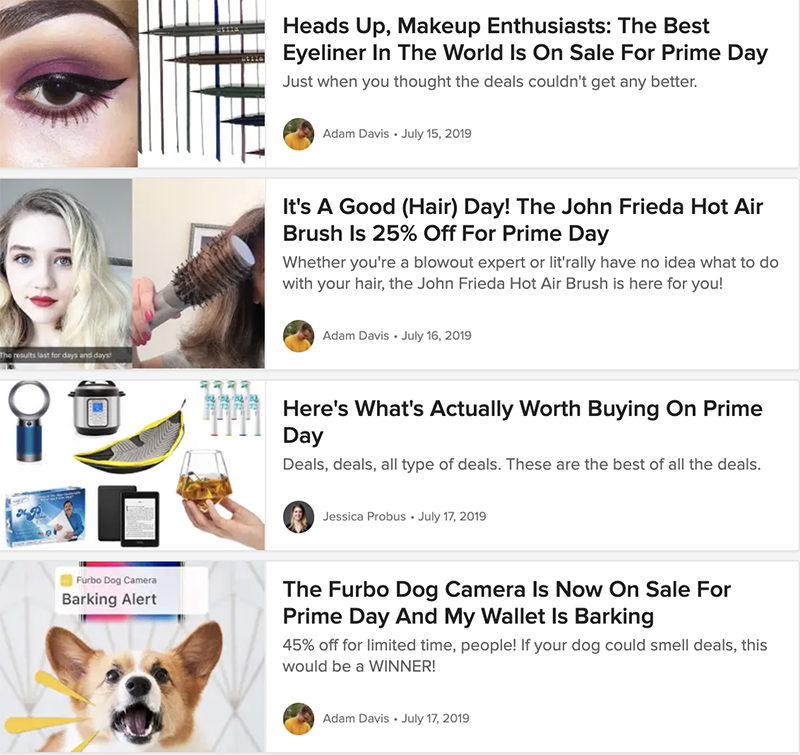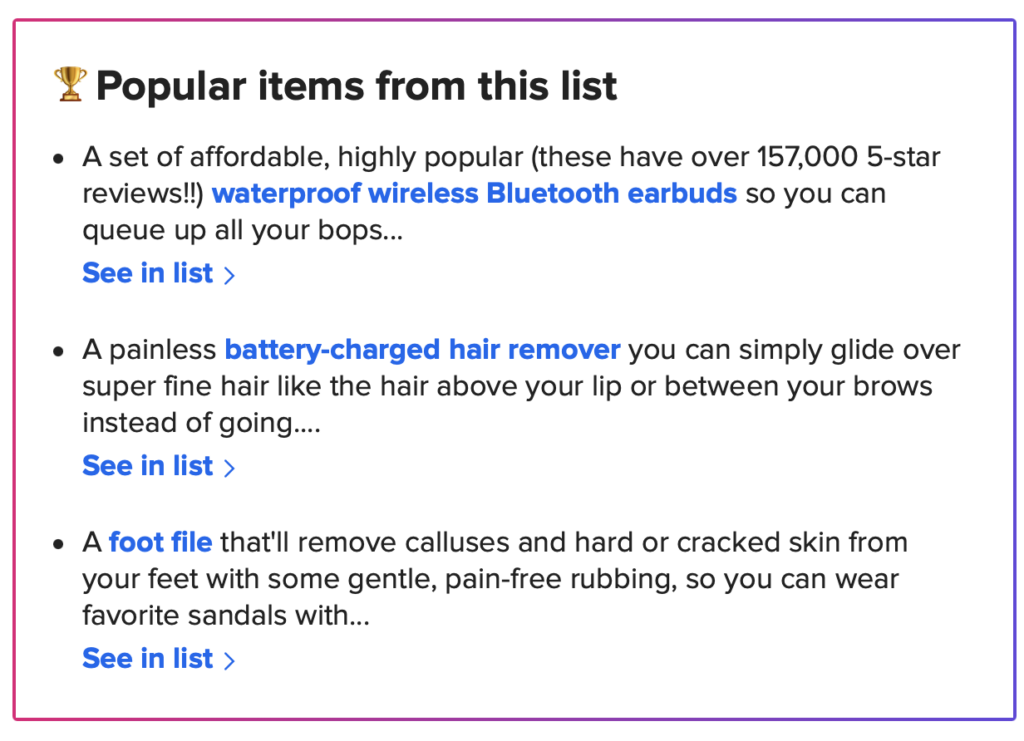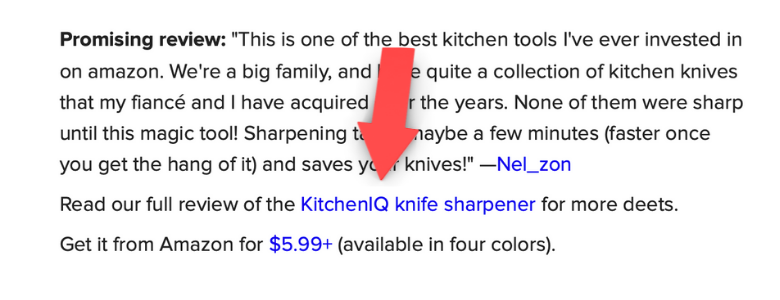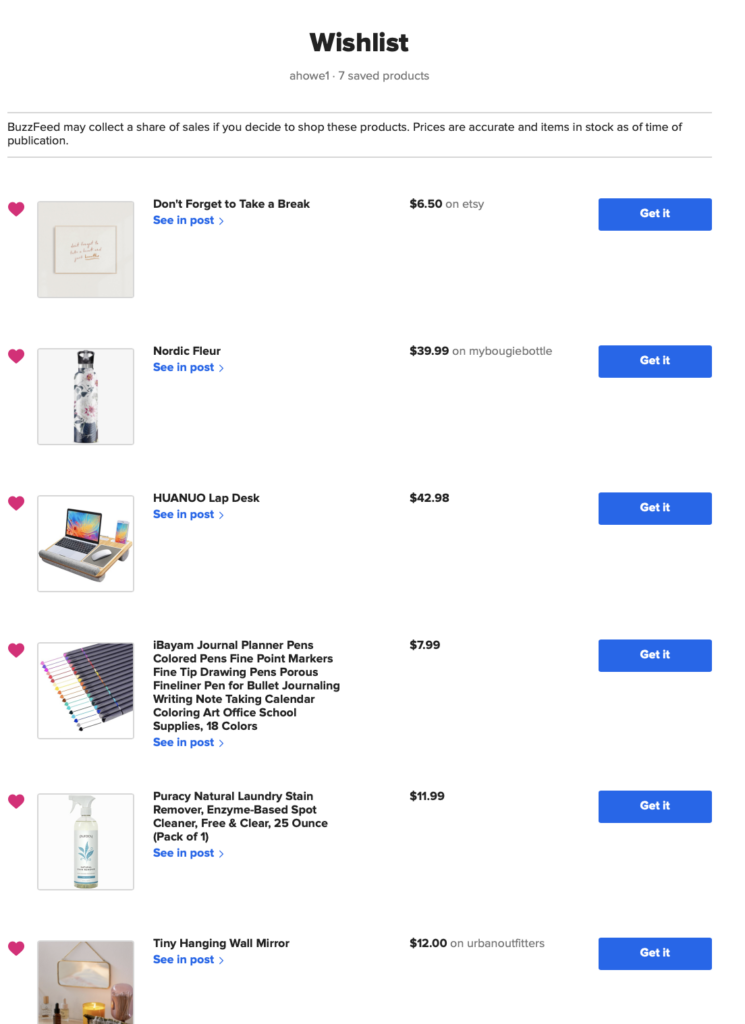eCommerce
Affiliate Marketing
eCommerce
Affiliate Marketing

It all starts with a social media post. A light-hearted but intriguing headline.
I click on it. You click on it. We all click on it.

And just like that, we’re sucked in. Mindlessly scrolling through products we don’t need, nor will likely ever need.

That’s the power of affiliate marketing on Buzzfeed.
This article will examine how BuzzFeed mastered affiliate marketing and became one of the most effective marketing channels for mega e-commerce retailers like Amazon and Walmart.
BuzzFeed.com is a digital media company focused on producing original viral content for millennials, including articles, news and entertainment, quizzes, Buzzfeed reviews, and videos based around human interest & pop culture topics. Popular with college students and millennials alike, it was set up in 2006 by Jonah Peretti and John S. Johnson III. Now, Kenneth Lerer who was co-founder and chairman at the Huffington Post is the executive chairman.
The site is most known for its “Listicles.” The term may be unfamiliar.
You likely know what it is. The content is part article and part list. Think of any articles like “5 of the best moisturizers for oily skin” or “The 10 Things You Need For Winter”.
That’s BuzzFeed.
And the content strategy has worked pretty well for them, with a global audience of over 520 million and 3+ billion content views a month.
Posts that include affiliate links have a disclaimer added in between the title and the article itself.
Affiliate links play a significant part in BuzzFeed’s overall strategy. 7 in 10 users say that Buzzfeed content inspires them to make purchase decisions, and in 2019, BuzzFeed drove more than $425M in directly attributable transactions. But looking beyond being a source of revenue, BuzzFeed co-founder says this is a way to change the entire marketing ecosystem.
This strategy emphasizes the benefits of affiliate marketing like:
The content from BuzzFeed has proven to be particularly effective for affiliate marketing. Rather than just showing the product and providing a link, the site has become an expert in developing unique content with affiliate promotions weaved in. They are slaying the game when it comes to affiliate marketing.
A key aspect of BuzzFeed’s content is that readers learn something. Although sometimes trivial, the content is informative and also interesting.
For instance, they know audiences aren’t interested in an article about home loans. But they would be drawn to titles like “10 Ways To Trick Yourself Into Saving Money”. Using memes and one-liners, this article is an easy read for audiences, all while still including a pitch for how Bank of America can help with finances.
BuzzFeed also creates engaging content.
This is particularly true for BuzzFeed Quizzes. With nearly 8 quizzes posted every single day, the content has kept users hooked. So much so that 96% of users who start BuzzFeed quizzes actually finish them.
With affiliate promotions strategically placed within the quiz, this content builds brand awareness and directly leads users to buy the products they selected throughout the quiz.
BuzzFeed has drawn in massive brands for affiliate promotions, ranging from finance like American Express & Bank of America to automotive like Volkswagen & Toyota and everyday fashion like H&M and Kohls.
The site has even made dedicated partnerships through their Tasty cooking video series with Walmart. The partnership involves creating recipes featuring ingredients that readers can purchase with Walmart’s online grocery shopping. Additionally, in November 2020, Buzzfeed joined forces with Belessa in a strategic partnership utilizing affiliate marketing, original products, and media sponsorship with their sex and love category.
But above all else, the most significant brand presence on BuzzFeed comes from the biggest e-commerce retailer: Amazon.
Amazon products have become a fixture in BuzzFeed’s content. There are even dedicated tabs and shopping features that drive customers to buy via affiliate links.
This is always most evident on Amazon Prime Day. For the big sale, Amazon completely takes over the site with an enormous amount of content being Prime Day-specific listicles to ramp up traffic for BuzzFeed’s shopping page.

By experimenting with content in the weeks leading up to Prime Day, BuzzFeed optimized their content strategy and focused on promoting high-converting products. Their experimentation resulted in huge numbers, with over 904k+ content clicks in 2 days.
Additionally, Buzzfeed has its own branded Amazon shop, which earns them affiliate commission, too, even if you go directly to the page. On it, they have a scrollable story bar with short excerpts about products, and different category lists, including “TikTok made me buy it” and “Cool Amazon Finds.” Here you can easily find the best Amazon products to buy according to Buzzfeed.


If you click on any of the categories, you’ll see a dropdown menu including images and the prices of the products. You can click on any one of these and buy. Simple, right?

Buzzfeed is an expert at convincing its readers that they need to go and buy something using social proof, and this marketing is powerful. Up to 88% of consumers trust user reviews as much as personal recommendations. And Buzzfeed nails this.
In any shopping-themed listicle, there are always different products.
At the top of each article, there is a list of popular items. Doing this is a great trick on the subconscious mind. It makes you think that others are buying this product, so it must be good.
The popular products list gives you a choice to go directly to the product or see it in the list. Social proof example number 1:

Underneath each item image, they include a short description explaining the product, a promising review from a happy customer underneath, and the price with a link to Amazon. The promising reviews are taken from Amazon itself and are not reviews by Buzzfeed staff. Buzzfeed does this because they know that people trust other users. Social proof example number 2:

If that wasn’t enough to convince you to buy something using a Buzzfeed affiliate link, if they have reviewed a product, they link to it right underneath the promising review, thus providing their readers with even more social proof.

If you click on the link, it takes you to a full in-depth review about the product, written by someone who has tried the product, and this includes all kinds of social proof as well. In short, Buzzfeed is convincing. Social proof example 3:

When convincing anyone to buy anything, making the process as straightforward as possible is one fundamental way to get people to buy. Buzzfeed is an absolute master at this and has optimized its website in a way that makes it easy to buy.
Not only do the products all have affiliate links which you can click on and go directly to the product on Amazon, but many of the items also have a bright pink button underneath each item to add to your wishlist. It stands out, and people are likely to click on it. It also means that you don’t need to stay in an article or save an article to find the products you wanted to buy, as everything gets saved in one place.

When you click “Add to wishlist,” it adds the product to a Buzzfeed list you can access when you log in, and it makes it so easy for you to buy. Everything you like is in one place. Then all you need to do is click on “Get it,” and you go straight to the item on the website. Simple, straightforward, and quick.

Not only that, but at the end of every article, they invite you to sign up for the newsletter, where they will send you products to your inbox, so you don’t even need to go to Buzzfeed to find things yourself. You can simply click on your email.

Buzzfeed’s shopping category is optimized to sell products. When you click on the shopping category, you get taken to a dedicated page. You can find all of the different articles and popular products listed here.

Designed to make you want to buy, the shopping category is persuasive. Browse through articles, popular products, and editors’ picks.
The articles convince you on one level, and popular products tell you that others are buying. Editors’ picks showcase popular articles in any given category. The whole page is screaming, “buy something.”

They even have Buzzfeed gift guides as well, in case you happened to be looking for a gift.

By putting everything in one place, making it simple, optimizing the website for sales, and providing social proof that is actually convincing, Buzzfeed has mastered its affiliate marketing strategy.
Self-reported insights showed that BuzzFeed’s commerce business, which includes affiliate links and product licensing, has grown to 21% of its total revenue in the past year from 9% in previous years.
On top of that, BuzzFeed has expanded its affiliate business to Japan, Australia, the U.K., Canada, Mexico, Brazil, and India. Expanding globally gives more opportunities for BuzzFeed to promote international brands and reach larger audiences using social proof, simplicity, and optimization to maximize their potential revenue.
BuzzFeed’s growing affiliate strategy — combined with the vested interest of big-name brands — gives the clear message that affiliate marketing is here to stay.
Ready to try out affiliate marketing for your business?? Try all the features: ?get a 14-day free trial here

Jessica Rangel
Spending my days writing marketing content, cycling around canals in Amsterdam and attempting to master the Dutch language.